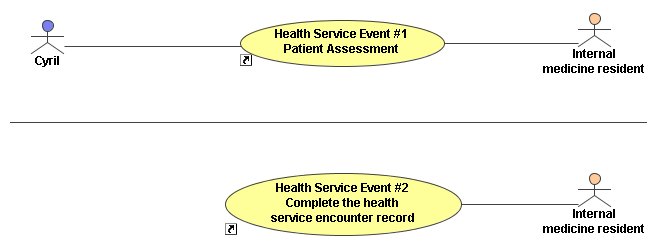
|
(Author: Brent Jones – April 20th, 2005)
Acute care hospital admission (7.1.2) Storyboard: CVA (7.1)
Cyril Lambert developed some weakness in the left side of his body and face earlier in the day. He eventually called an ambulance and was taken to the regional hospital in his area. After assessment in the ER there, Cyril was transferred to the tertiary care hospital in the nearest city. He was initially assessed in the ER there and underwent a computed tomography (CT) scan which suggested a cerebrovascular accident (CVA, or stroke). Cyril is to be admitted to the hospital.
The internal medicine resident on call that evening, Dr. Grey, assesses Cyril in the ER to admit him to hospital. He gets as much history as possible from Cyril and Mabel, but this is limited. He examines Cyril then reviews the CT images.
Dr. Grey reviews the ER notes in the hospital EMR and accesses Cyril’s records. He is able to view Cyril’s health profile and see his current and past medical problem list. He can also see the medications which have been prescribed. Dr. Grey searches for the 15 most recent lab results to get an idea of Cyril’s anticoagulation status. He also searches for the 10 most recent encounters with primary care providers and sees Cyril has been poorly compliant with recommendations made to him. After reviewing this information, Dr. Grey feels Cyril has had a stroke secondary to atrial fibrillation with poor anticoagulation. He creates a record of the admitting history and physical in the hospital EMR.
Assumptions
· Able to search EHR based on variables such as type of record (e.g. lab result, provider type)
Tables
Admission Exam
|
History of present illness |
Past medical history |
|
Family history |
Social history |
|
Functional inquiry |
Physical exam |
|
Allergies |
Medications |
|
Provisional diagnosis |
Management plan |
This health service follows upon the emergency medical transport (see 7.1.1) and describes all the health service events taken during the patient’s visit to the tertiary care hospital of the jurisdiction where the patient lives.
The patient also obtained other health services encounters for a chronic obstructive pulmonary disease (COPD – see 1.1.1); at this period, a health service encounter took place in another jurisdiction.
Each health service event takes place during a same period of time (e.g. without cut of time), in presence or not of involved client; the health service events can be grouped in a health service encounter.
| General Info | |
|---|---|
| Name | 7.1.2 Acute care hospital admission Encounter Diagram |
| Type | Use Case Diagram |